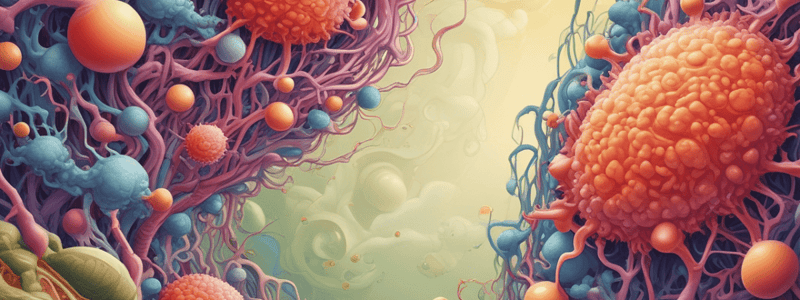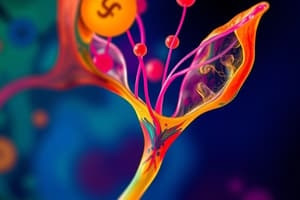Podcast
Questions and Answers
What type of neurotransmitter is released by Type III or presynaptic cells in taste buds?
What type of neurotransmitter is released by Type III or presynaptic cells in taste buds?
- Serotonin (correct)
- Dopamine
- Acetylcholine
- Norepinephrine
Which of the following substances do Type II taste receptor cells primarily release?
Which of the following substances do Type II taste receptor cells primarily release?
- GABA
- ATP (correct)
- Glutamate
- Serotonin
Which signal is primarily responsible for triggering the release of either serotonin or ATP from taste cells?
Which signal is primarily responsible for triggering the release of either serotonin or ATP from taste cells?
- K+ efflux
- cAMP levels
- Na+ influx
- Ca2+ signals (correct)
In the structure of a taste bud, which component is specifically designated to limit the movement of molecules between cells?
In the structure of a taste bud, which component is specifically designated to limit the movement of molecules between cells?
Which type of taste is NOT represented by the labeled areas in the taste bud diagram?
Which type of taste is NOT represented by the labeled areas in the taste bud diagram?
Flashcards are hidden until you start studying
Study Notes
Taste Bud Structure
- Taste buds contain two primary types of taste cells: Type II (receptor cells) and Type III (presynaptic cells).
- Type II cells release ATP as a neurotransmitter, essential for taste signaling.
- Type III cells release serotonin, playing a crucial role in transmitting taste information to the nervous system.
Taste Sensations
- Different regions of the taste bud are responsive to specific taste modalities:
- Sweet
- Umami
- Bitter
- Salty (detects sodium ions, Na+)
- Sour (detects hydrogen ions, H+)
Cellular Components
- Support cells (Type I) provide structural integrity and support to the taste bud.
- Receptor cells (Type II) interact with taste ligands and induce cellular signals.
- Primary gustatory neurons relay taste information from taste buds to the brain.
Signal Transduction
- Taste ligands bind to receptor cells, leading to an influx of calcium ions (Ca2+).
- Increased intracellular Ca2+ levels trigger the release of neurotransmitters (serotonin or ATP).
- Tight junctions between cells minimize the movement of molecules and help maintain the functionality of the taste bud.
Studying That Suits You
Use AI to generate personalized quizzes and flashcards to suit your learning preferences.



